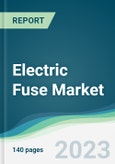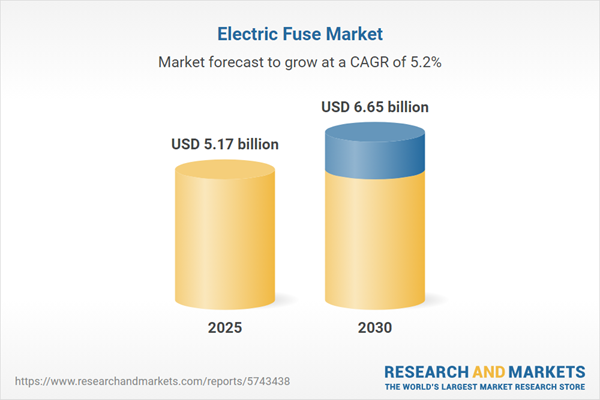The Electric Fuse Market is expected to grow from USD 5.167 billion in 2025 to USD 6.655 billion in 2030, at a CAGR of 5.19%.
The global electric fuse market is poised for steady growth from 2025 to 2030, driven by increasing demand in the automotive sector, rapid industrialization, and technological advancements in fuse design. Electric fuses, critical safety devices in electrical circuits, protect against overcurrent and short circuits by interrupting excessive current flow, preventing damage, fires, and hazards. The market is fueled by the rise of electric vehicles (EVs), growing energy demands, and infrastructure modernization, with significant contributions from the United States and India. Challenges include competition from alternative circuit protection devices and high development costs for advanced fuses.
The electric fuse market is set for robust growth from 2025 to 2030, driven by the automotive sector’s shift to EVs, technological advancements in fuse design, and rising energy demands in the United States and India. Despite challenges from alternative technologies and supply chain constraints, the market’s outlook is positive, particularly in North America and Asia-Pacific. Industry players must focus on innovative, cost-effective fuse solutions to meet the evolving needs of automotive and energy applications, ensuring safety and reliability in complex electrical systems.
By Voltage
By Material
By End-User Industry
By Country
By Voltage
By Material
By End-User Industry
By Country
By Voltage
By Material
By End-User Industry
By Country
By Voltage
By Material
By End-User Industry
By Country
By Voltage
By Material
By End-User Industry
By Country
The global electric fuse market is poised for steady growth from 2025 to 2030, driven by increasing demand in the automotive sector, rapid industrialization, and technological advancements in fuse design. Electric fuses, critical safety devices in electrical circuits, protect against overcurrent and short circuits by interrupting excessive current flow, preventing damage, fires, and hazards. The market is fueled by the rise of electric vehicles (EVs), growing energy demands, and infrastructure modernization, with significant contributions from the United States and India. Challenges include competition from alternative circuit protection devices and high development costs for advanced fuses.
Market Drivers
Growing Demand from the Automotive Sector
The automotive industry, particularly the rise of electric and hybrid vehicles, is a major driver of the electric fuse market. In India, the robust automotive sector, a global leader in tractor production and a significant player in buses and heavy trucks, demands advanced fuses to protect complex electrical systems in EVs. High-performance fuses, such as those for onboard chargers and battery management systems, are critical for ensuring safety and reliability. The increasing adoption of EVs, supported by government initiatives like India’s Automotive Mission Plan 2016-26, drives demand for specialized fuses capable of handling high voltages and currents, boosting market growth.Technological Innovations
Advancements in fuse technology are propelling market expansion. Innovations such as high-voltage, compact fuses designed for EV applications and smart fuses with real-time monitoring capabilities enhance safety and efficiency. For instance, recent product launches include fuses meeting AEC-Q200 Rev E standards, offering durability in harsh automotive environments. These developments cater to the growing complexity of automotive electronics and renewable energy systems, driving demand for reliable, high-performance fuses across the United States and India.Rising Energy Demand and Infrastructure Modernization
The United States is experiencing increased electricity demand due to rapid industrialization and household consumption, necessitating robust circuit protection solutions. Government initiatives, such as the U.S. Department of Energy’s Grid Resilience and Innovation Partnerships program, with nearly USD 2 billion allocated in November 2024, support grid modernization and renewable energy integration, boosting demand for electric fuses in power and energy applications. Similarly, India’s focus on sustainable energy and infrastructure development enhances the need for fuses in renewable energy systems like solar and wind, further driving market growth.Market Restraints
The electric fuse market faces challenges from alternative circuit protection devices, such as miniature circuit breakers, which offer reusability and enhanced safety features. High development costs for advanced fuses, particularly those for high-voltage EV applications, can limit adoption in cost-sensitive markets. Additionally, the global semiconductor shortage impacts fuse production, increasing costs and causing supply chain delays, particularly for surface-mount and smart fuses. These constraints require manufacturers to innovate cost-effective solutions to maintain competitiveness.Market Segmentation
By Type
The market includes blade, cartridge, high-voltage, and smart fuses. High-voltage fuses are gaining traction in EV and renewable energy applications, while smart fuses with diagnostic capabilities are emerging in industrial and grid settings.By Application
The market is segmented into automotive, industrial, power and energy, and consumer electronics. The automotive sector, particularly EVs, is the fastest-growing segment, driven by increasing vehicle electrification. Power and energy applications are significant due to grid modernization efforts.By Geography
The market is segmented into North America, Asia-Pacific, Europe, South America, and the Middle East and Africa. The United States leads in North America, driven by industrialization, EV adoption, and government funding for grid resilience. India, within Asia-Pacific, shows rapid growth due to its expanding automotive and renewable energy sectors, supported by government initiatives.The electric fuse market is set for robust growth from 2025 to 2030, driven by the automotive sector’s shift to EVs, technological advancements in fuse design, and rising energy demands in the United States and India. Despite challenges from alternative technologies and supply chain constraints, the market’s outlook is positive, particularly in North America and Asia-Pacific. Industry players must focus on innovative, cost-effective fuse solutions to meet the evolving needs of automotive and energy applications, ensuring safety and reliability in complex electrical systems.
Key Benefits of this Report:
- Insightful Analysis: Gain detailed market insights covering major as well as emerging geographical regions, focusing on customer segments, government policies and socio-economic factors, consumer preferences, industry verticals, and other sub-segments.
- Competitive Landscape: Understand the strategic maneuvers employed by key players globally to understand possible market penetration with the correct strategy.
- Market Drivers & Future Trends: Explore the dynamic factors and pivotal market trends and how they will shape future market developments.
- Actionable Recommendations: Utilize the insights to exercise strategic decisions to uncover new business streams and revenues in a dynamic environment.
- Caters to a Wide Audience: Beneficial and cost-effective for startups, research institutions, consultants, SMEs, and large enterprises.
What do businesses use our reports for?
Industry and Market Insights, Opportunity Assessment, Product Demand Forecasting, Market Entry Strategy, Geographical Expansion, Capital Investment Decisions, Regulatory Framework & Implications, New Product Development, Competitive IntelligenceReport Coverage:
- Historical data from 2020 to 2024 & forecast data from 2025 to 2030
- Growth Opportunities, Challenges, Supply Chain Outlook, Regulatory Framework, and Trend Analysis
- Competitive Positioning, Strategies, and Market Share Analysis
- Revenue Growth and Forecast Assessment of segments and regions including countries
- Company Profiling (Strategies, Products, Financial Information, and Key Developments among others.
Segmentation:
By Type- Power Fuse & Fuse Link
- Distribution Cutouts
- Cartridge & Plug Fuse
- Low
- Medium
- High
- Copper
- Silver
- Bronze
- Energy and Power
- Automotive
- Manufacturing
- Consumer Electronics
- Construction
- Others
- North America
By Voltage
By Material
By End-User Industry
By Country
- USA
- Canada
- Mexico
- South America
By Voltage
By Material
By End-User Industry
By Country
- Brazil
- Argentina
- Others
- Europe
By Voltage
By Material
By End-User Industry
By Country
- Germany
- Spain
- United Kingdom
- France
- Others
- Middle East and Africa
By Voltage
By Material
By End-User Industry
By Country
- Saudi Arabia
- South Africa
- Others
- Asia Pacific
By Voltage
By Material
By End-User Industry
By Country
- China
- Japan
- Australia
- Japan
- India
- Others
Table of Contents
1. INTRODUCTION
2. RESEARCH METHODOLOGY
3. EXECUTIVE SUMMARY
4. MARKET DYNAMICS
5. ELECTRIC FUSE MARKET ANALYSIS, BY TYPE
6. ELECTRIC FUSE MARKET ANALYSIS, BY VOLTAGE
7. ELECTRIC FUSE MARKET ANALYSIS, BY MATERIAL
8. ELECTRIC FUSE MARKET ANALYSIS, BY END-USER INDUSTRY
9. ELECTRIC FUSE MARKET ANALYSIS, BY GEOGRAPHY
10. COMPETITIVE ENVIRONMENT AND ANALYSIS
11. COMPANY PROFILES
Companies Mentioned
- Abb Ltd
- Schneider Electric
- Siemens Ag
- Bel Fuse Inc
- Legrand
- Eaton Corporation
- Mersen LP
- S&C Electric Company
- Hubbel Incorporated Designs
- Panasonic Corporation
- Mitsubishi Electric
Table Information
| Report Attribute | Details |
|---|---|
| No. of Pages | 140 |
| Published | August 2025 |
| Forecast Period | 2025 - 2030 |
| Estimated Market Value ( USD | $ 5.17 billion |
| Forecasted Market Value ( USD | $ 6.65 billion |
| Compound Annual Growth Rate | 5.1% |
| Regions Covered | Global |
| No. of Companies Mentioned | 11 |









